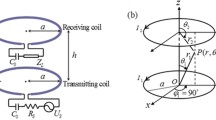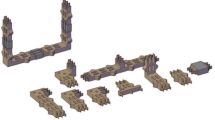Abstract
A power line system consisting of multi-conductors above the ground is decomposed into a metal return (or balanced) and a ground return (unbalanced) circuit in terms of propagation modes. Power line radiation above the ground is sorted into two classes, transition radiation from discontinuities which takes place from a line of finite length and Čerenkov-like radiation from a ground return or unbalanced circuit due to the Earth's finite conductivity and dielectric properties. Čerenkov-like radiation is thought to be predominant and to be a main source origin of power line radiation and, therefore, is specifically discussed in this paper. The problem is reduced simply to wave propagation along an infinite wire above the ground, without taking into account line discontinuities and ionospheric effects. It is shown that a TEM-type wave of a ground return circuit at low frequencies virtually transfers to the principal TM wave of a surface waveguide at high frequencies, via a hybrid EH-type wave in an intermediate range of frequencies, i.e., ‘transition region’ with increasing frequency. Consequently, the attenuation characteristics of wave propagation, which should include radiation losses as well as ohmic losses in the wire and in the ground, possess a maximum and minimum at certain frequencies in the transition region. This is due to two reasons: one is that the Earth transfers to a dielectric from a conductor and the other is that the field concentrates more densely around the wire with increasing frequency. Experimental evidence of this phenomenon is also given.
Similar content being viewed by others
Abbreviations
- a :
-
radius of wire (conductor)
- a′ :
-
outer radius of dielectric coated wire
- A :
-
vector potential
- B :
-
magnetic induction
- c :
-
velocity of light
- D :
-
electric displacement
- E :
-
electric field
- h :
-
height of wire
- H :
-
magnetic field
- H n(1) :
-
Hankel function of the first kind and order n
- i :
-
conduction current
- I :
-
total axial current in wire
- j :
-
√-1
- J n :
-
Bessel function of the first kind and order n
- k :
-
propagation constant in medium = k (r) + jk(i), (k(r) > 0, k(i) < 0)
- Q :
-
total charge per unit length
- r :
-
position vector at the consideration point
- r 0 :
-
position vector at the centre of wire
- V :
-
scalar potential
- V :
-
transverse voltage = V 1 (0, h — a)
- x, y, z :
-
rectangular coordinates
- Y :
-
parallel admittance per unit length
- Z :
-
series impedance per unit length = Z i + Ze
- Z i :
-
internal series impedance
- Z e :
-
external series impedance
- α:
-
attenuation constant
- β :
-
phase constant
- γ :
-
1.78107... = e c, where c = Euler's constant
- Γ :
-
propagation factor or constant
- δ :
-
Dirac's delta function; skin depth
- tan δ :
-
loss factor = σ/ωε
- ε :
-
dielectric constant
- ε 0 :
-
dielectric constant of free space
- λ:
-
√k 2 + Γ 2
- σ :
-
conductivity
- μ :
-
permeability
- μ 0 :
-
permeability of free space
- ξ, η, ζ :
-
unit vectors in rectangular coordinates
- ω :
-
angular frequency = 2πf
- Π :
-
Herz vector
References
Bullough, K.: 1983, Space Sci. Rev. 35 175 (this volume).
Carson, J. R.: 1926, Bell System Tech. J. 5, 539.
Chiba, J. and Sato, R.: 1974, Tech. Rep. Tohoku Univ. 39, 183.
Goubau, G.: 1950, J. Appl. Phys. 21, 1119.
Jelley, J. V.: 1958, Čerenkov Radiation and Its Applications, Pergamon Press, New York, London, p. 52.
Kikuchi, H.: 1955, J. Inst. Elec. Eng. Japan 75, 1176.
Kikuchi, H.: 1956, Electrotech. J. Japan 2, 73.
Kikuchi, H.: 1957a, L'onde Elec. 38 (Special Suppl.: Proc. Int. Cong. on Ultra-High Frequency Circuits and Antennas, Paris, Oct., Vol. 1), 39; Bull. Electrotech. Lab. Japan 21, 49.
Kikuchi, H.: 1957b, J. Inst. Elec. Eng. Japan 77, 721; Bull. Electrotech. Lab. Japan 21, 439.
Kikuchi, H.: 1972, in Proc. Symp. on Electromagnetic Hazards, Pollution and Environmental Quality, Purdue Univ. Lafayette, Indiana, p. 147.
Kikuchi, H.: 1973, Proc. IEE 120, 637.
Kikuchi, H.: 1978, Proc. IEEE 66, 351.
Kikuchi, H.: 1983, Space Sci. Rev. 35, 33 (this issue).
Kikuchi, H. and Iguchi, M.: 1954, Bull. Electrotech. Lab. Japan 18, 527.
Kohno, S., Murata, H., Makuta, K., and Ito, M.: 1961, Bull. Furukawa Elec. Co. 27, 1.
Pollaczek, F.: 1926, Elek. Nachr. Tech. 3, 339.
Sommerfeld, A.: 1899, Ann. Phys. Chem. 67, 233.
Wait, J. R. and Hill, D. A.: 1976, J. Appl. Phys. 47, 5472.
Wait, J. R. and Hill, D. A.: 1977, Int. J. Electronics 42, 377.
Author information
Authors and Affiliations
Rights and permissions
About this article
Cite this article
Kikuchi, H. Power line transmission and radiation. Space Sci Rev 35, 59–80 (1983). https://doi.org/10.1007/BF00173693
Issue Date:
DOI: https://doi.org/10.1007/BF00173693




